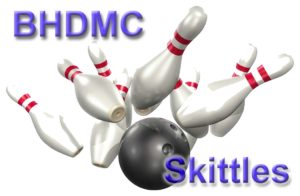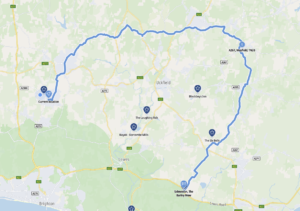Helmets are compulsory and must be marked BS 6658 1985 or UN/ECE 22-05. A sidecar driver and pillion passenger must wear a helmet but sidecar passengers do not require a helmet. Trike regulations are more complicated. A trike rider or passenger may have to wear a helmet and some may even have to wear seat belts depending on vehicle licensing classification. Such things as weight of the machine and whether you sit astride or in a seat are factors that have to be considered. You should check with the DVLC to find the correct classification.
Visors To be legal they must conform to BS 4110, which ensures a level of scratch resistance and permits up to 50% light transmittance. Any other visors are illegal but sunglasses, tear-offs and inner wraparounds are permitted.
Pillion Passengers No age limit but MUST be able to place both feet on the pillion footrests.
Protective body armour Effective body armour should carry a CE marking. The most common is EN 1621-1 covering the impact performance and dimensional requirements of armour designed to protect elbows, hips, knees and shoulders. These work by reducing the peak force on the rider’s body and are generally fitted into the clothing. Although in draft form, there are currently no agreed standards for back protectors. Protective clothing The following standards are intended for professional riders, but clothing made to these standards will be available to all road riders: Clothing: Standard BS EN 13595-1: 2002 or EN 13595-1 Boots: Standard BS EN 13634: 2002 or EN 13634 Gloves: Standard still in draft form. .
Drink/driving or a dangerous driving conviction will result in an automatic 12-month ban, for repeat offenders or high alcohol levels it may be longer. Two drink driving offences within 10 years could get you a three-year ban. Doctors are now able to take blood to test from unconscious or incapacitated drivers without their consent.
Totting Up Under the totting up scheme, points generally last for three years; however, after disqualification, you cannot apply for a new licence until the end of the fourth year. In other circumstances, points can last longer, as follows: 11 years from date of conviction for offences relating to drink /drugs and driving, such as causing death by careless driving whilst under the influence of drink/ drugs and causing death by careless driving then failing to provide a specimen for analysis 4 years from date of conviction for reckless/ dangerous driving and offences resulting in disqualification.
Headlights must show a white light or yellow tint, any other colour is illegal. The headlight bulb must not be above 55 watts but there is no limit to the number of headlamps on bikes constructed or registered after 1984. Before 1985 there is no limit and there is no requirement for it to have an E stamp on it.
.
Indicators are not a legal requirement but if fitted they must work.
Number plates must conform to BS AU 145a or from 1st September 2001, to BS AU 145d: Must have black characters on yellow background. Only the authorised font, or something substantially similar is permitted. Characters: Height: 64mm. Width: 44mm. Stroke width: 10mm. Space between characters: 10mm. Space between groups: 30mm. Top, side and bottom margin: 11mm. Symbols/Emblems: the Euro Stars with GB is the only permitted symbol on UK number plates. New plates from 1st September 2001 must carry the makers’ name/ trademark or other means of ID of maker, plus name and postcode of supplying outlet. Black background plates with white or silver letters are only legal on pre 1st January 1973 machines.
Silencers All replacement silencers/exhausts must, for road use, be marked as follows: EU e mark or UNECE E mark e.g. e11 or E11 and an approval number e.g. 007 or BS AU 193/T2 or BS AU 193a:1990/T2 or BS AU 193a 1990/T3 . If marked NOT FOR ROAD USE it is not road-legal.
Speedometers must be marked in miles per hour. A conversion sticker on the face of the speedometer for kph clocks is acceptable.
VED (Tax) Discs It is not sufficient for your bike just to be taxed, the tax disc must also be displayed in front of the rider on the nearside. VED (Tax) Exemption All vehicles first registered on or before 1st January 1973 are exempt road fund duty.
Tyres Must have tread depth of at least 1mm across three-quarters of the breadth of the tread and in a continuous band around the entire circumference. (This is the minimum legal requirement but be guided by your bike handbook for recommended replacement wear levels.)
Accidents If you are involved in a road accident while riding and: – Someone is injured – Damage occurs to another vehicle or property – An animal is injured or killed
You must: – Stop and remain at the scene for a reasonable period – Give your vehicle and personal details ie registration number of vehicle, name and address and details of the vehicle owner, if different, to anyone who has reasonable grounds
for requesting these details – If you do not give your details at the time of accident, you should report the accident to the Police as soon as is reasonable and, in any case, within 24 hours.
In cases of injury to another person, you must also: – Produce your insurance certificate at the scene, if required to do so by anyone with reasonable grounds.
If you do not, you must: – Report the accident to the Police as soon as is possible and, in any case, within 24 hours – Produce your insurance certificate to the Police within 7 days.
You should also report any accident to your insurance company as soon as is reasonable to do so. All Police Forces tend to conduct breathalyser tests after serious road accidents. Refusing a breathalyser is an offence that carries serious penalties. If you have been involved in an accident that wasn’t your fault, call the BMF Biker Legal Line on 08000 856 243
Make sure you get the names and address of witnesses, details of vehicles and people involved, and report the accident to the police.
Stop checks What the Police expect from you:
Stop when required to by a uniformed police officer. Ensure you pull over in a safe place. Wait by your machine and let the Police Officer approach you. Be civil with the Police Officer. Don’t forget he/she has discretion in regards to offences you may be reported for or fined. If you conduct yourself in a civil manner, you may simply get a warning .
If you are not carrying your driving licence, insurance certificate or MOT, the Officer may issue you with a notice requiring you to produce these documents at a named Police Station within 7 days ,named Police Station within 7 days.
What you should expect from the Police:
You should be treated in a civil manner by the Officer.
If you have committed an offence, the Officer should explain this and then take one of the following courses of action:
Report you for Summonsing Issue you a fixed penalty ticket Issue a vehicle rectification notice
Although the Officer has the right to seize your property as evidence of an offence, but not damage it
If your property is seized as evidence e.g. number plate or exhaust system consider your position before proceeding in light of further offences being committed.
If you feel you have been unfairly treated, you should:
Make a note of the Officer’s badge number and station then:
Make a formal complaint by contacting (in person or by telephone) the relevant Police Station. Ask to speak to the Duty Inspector and advise them of your complaint.
Prosecution by fixed or mobile safety (speed) cameras:
In circumstances where an oral notice of prosecution is not given at the time of the offence then a summons or written notice of prosecution (NIP) must be served within fourteen days.
The Road Traffic Offenders Act 1988 states that a failure to comply with the 14 day requirement is no bar to conviction if a court is satisfied that the name and address of the accused or of the vehicles registered keeper could not be ascertained in time to serve a summons or NIP.
If you are in any doubt whatsoever in regard to a prosecution involving a safety camera offence then seek legal advice.
Extract from BMF Guide “Know your Rights”






